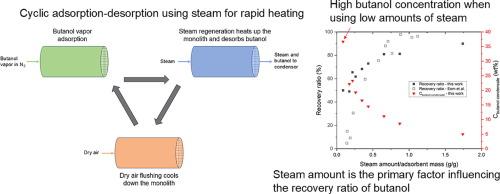利用活性炭整体研究蒸汽再生作为生物丁醇回收的快速变温吸附法
IF 8.1
1区 工程技术
Q1 ENGINEERING, CHEMICAL
引用次数: 0
摘要
本文章由计算机程序翻译,如有差异,请以英文原文为准。

Investigating steam regeneration as rapid temperature swing adsorption method for biobutanol recovery using an activated carbon monolith
An activated carbon monolith was utilized for biobutanol recovery in a rapid temperature swing adsorption (RTSA) process with steam regeneration. We conducted cyclic adsorption–desorption experiments to assess the process performance under varying steam flow rates, steam durations, and flushing conditions. The results indicate that steam regeneration efficiently removes biobutanol, increasing the butanol concentration in the condensate by up to 37 wt%, which is an 18-fold increase compared to the inlet concentration. Although higher steam flow rates or longer steam durations improved butanol adsorption capacity, they led to a reduced butanol concentration in the recovered product, indicating a trade-off between capacity and product concentration. We observed that the total amount of steam used during the regeneration step is the primary factor influencing recovery and product concentration. The optional flushing step did not significantly impact cyclic performance, suggesting that it can be omitted without affecting process efficiency. These findings underscore the potential of steam regeneration on activated carbon monoliths as an effective adsorbent for biobutanol recovery, providing a promising alternative to more energy-intensive separation methods.
求助全文
通过发布文献求助,成功后即可免费获取论文全文。
去求助
来源期刊

Separation and Purification Technology
工程技术-工程:化工
CiteScore
14.00
自引率
12.80%
发文量
2347
审稿时长
43 days
期刊介绍:
Separation and Purification Technology is a premier journal committed to sharing innovative methods for separation and purification in chemical and environmental engineering, encompassing both homogeneous solutions and heterogeneous mixtures. Our scope includes the separation and/or purification of liquids, vapors, and gases, as well as carbon capture and separation techniques. However, it's important to note that methods solely intended for analytical purposes are not within the scope of the journal. Additionally, disciplines such as soil science, polymer science, and metallurgy fall outside the purview of Separation and Purification Technology. Join us in advancing the field of separation and purification methods for sustainable solutions in chemical and environmental engineering.
 求助内容:
求助内容: 应助结果提醒方式:
应助结果提醒方式:


